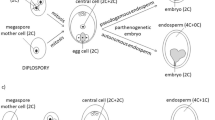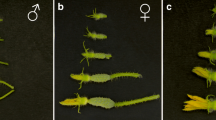Abstract
Molecular cytogenetic analysis of Lupinus angustifolius and Lupinus cosentinii was performed using flow cytometry, fluorescence in situ hybridisation (FISH) and differential chromosome staining. Genome size was determined as 2.07 pg for L. angustifolius and 1.54 pg for L. cosentinii. Analysis of nuclear DNA amount in cells during plant development has shown endopolyploidisation in different organs. The highest level of endopolyploidy was in cotyledons and reached 32C in L. angustifolius and 64C in L. cosentinii. Both of the investigated Lupinus species belong to the polysomatic type of plants. Double FISH with rDNA probes provided chromosomal landmarks for 10 out of 40 chromosomes for L. angustifolius and 8 out of 32 chromosomes for L. cosentinii. In L. angustifolius, the number and localisation of 25S rDNA hybridisation signals precisely corresponded to the chromomycin A3 (CMA+) bands, while in L. cosentinii both 25S and 5S rDNA loci overlapped with CMA+ bands. Silver staining revealed that only 45S rRNA genes located in secondary constriction regions were transcriptionally active. FISH with Arabidopsis-type telomeric arrays revealed the presence of signals at termini of all chromosomes. Despite the application of different DNA probes for FISH and different chromosome staining, a relatively small proportion of chromosomes in the Lupinus karyotypes can be distinguished. Identification of all chromosomes requires the use of more chromosome-specific markers.



Similar content being viewed by others
References
Adams SP, Leitch IJ, Bennet MD, Leitch AR (2000) Aloe L., a second plant family without (TTTAGGG)n telomeres. Chromosoma 109:201–205
Ali HBM, Meister A, Schubert I (2000) DNA content, rDNA loci and DAPI bands reflect the phylogenetic distance between Lathyrus species. Genome 43:1027–1032
Aïnouche A-K, Bayer RJ (1999) Phylogenetic relationships in Lupinus (Fabaceae: Papilionoideae) based on internal transcribed spacer sequences (ITS) of nuclear ribisomal DNA. Am J Bot 84:590–607
Ansari HA, Ellison NW, Reader SM, Badaeva ED, Friebe B, Miller TE, Williams WM (1999) Molecular cytogenetic organization of 5S and 18S-16S rDNA loci in white clover (Trifolium repens L.) and related species. Ann Bot 83:199–206
Dolezel J, Sgorbati S, Lucretti S (1992) Comparison of three DNA fluorochromes for flow cytometric estimation of nuclear DNA content in plants. Physiol Plant 85:625–631
Dolezel J, Dolezelova M, Novak FJ (1994) Flow cytometric estimation of nuclear DNA amount in diploid bananas (Musa acuminata and M. balbisiana. Biol Plant 36:351–357
Dolezel J, Greilhuber J, Lucretti S, Meister A, Lysak MA, Nardi L, Obermayer R (1998) Plant genome size estimation by flow cytometry: inter-laboratory comparison. Ann Bot 82:17–26
Dong F, Song J, Naess SK, Helgeson JP, Gebhardt C, Jiang J (2000) Development and application of a set of chromosome-specific cytogenetic DNA markers in potato. Theor Appl Genet 101:1001–1007
Doudrick RL, Heslop-Harrison JS, Nelson CD, Schmidt T, Nance WL, Schwarzacher T (1995) Karyotype of slash pine (Pinus elliottii var. elliottii) using patterns of fluorescence in situ hybridisation and fluorochrome banding. J Hered 86:286–296
Fay MF, Chase MW (1996) Resurrection of Themidaceae for the Brodiaea alliance and re-circumscription of Alliaceae, Amaryllidaceae and Agapanthoideae. Taxon 45:441–451
Fransz P, Armstrong S, Alonso-Blanco C, Fisher TC, Torres-Ruiz R, Jones G (1998) Cytogenetics for the model system Arabidopsis thaliana. Plant J 13:867–876
Galasso I, Schmidt T, Pignone D, Heslop-Harrison JS (1995) The molecular cytogenetics of Vigna unguiculata (L.) Walp: the physical organization and characterization of 18S-5.8S–25S rRNA genes, 5S rRNA genes, telomere-like sequences, and a family of centromeric repetitive DNA sequences. Theor Appl Genet 91:928–935
Galbraith DW, Harkins KR, Knapp S (1991) Systemic endopolyploidy in Arabidopsis thaliana. Plant Physiol 96:985–989
Gerlach WL, Dyer TA (1980) Sequence organization of the repeating units in the nucleus of wheat which contain 5S rRNA genes. Nucleic Acids Res 11:4851–4865
Hasterok R, Maluszynska J (2000a) Cytogenetic analysis of diploid Brassica species. Acta Biol Cracov Ser Bot 42:145–153
Hasterok R, Maluszynska J (2000b) Nucleolar dominance does not occur in root tip cells of allotetraploid Brassica species. Genome 43:574–579
Hasterok R, Jenkins G, Langdon T, Jones RN, Maluszynska J (2001) Ribosomal DNA is an effective marker of Brassica chromosomes. Theor Appl Genet 103:486–490
Hizume M, Sato S, Tanaka A (1980) A highly reproducible method of nucleolus organizer regions staining in plants. Stain Technol 55:87–90
Hoshi Y, Plader W, Malepszy S (1999) Physical mapping of 45S rRNA gene loci in the cucumber (Cucumis sativus L.) using fuorescence in situ hybridization. Caryologia 52:49–57
Howell EC, Barker GC, Jones GH, Kearsey MJ, King GJ, Kop EP, Ryder CD, Teakle GR, Vicente JG, Armstrong SJ (2002) Integration of the cytogenetic and genetic linkage maps of Brassica oleracea. Genetics 161:1225–1234
Joubes J, Chevalier C (2000) Endoreduplication in higher plants. Plant Mol Biol 43:735–745
Kitamura S, Inoue M, Shikazono N, Tanaka A (2001) Relationships among Nicotiana species revealed by the 5S rDNA spacer sequence and fluorescence in situ hybidization. Theor Appl Genet 103:678–686
Kudo N, Kimura Y (2001) Flow cytometric evidence for endopolyploidy in seedlings of some Brassica species. Theor Appl Genet 102:104–110
Kulak S, Hasterok R, Maluszynska J (2002) Karyotyping of Brassica amphidiploids using 5S and 25S rDNA as chromosome markers. Hereditas 136:144–150
Lagunes-Esponoza LC, Huyghe C, Bousseau D, Barre P, Papineau J (2000) Endoreduplication occurs during pad wall development in temperate grain legumes. Ann Bot 86:185–190
Larkins BA, Dilkes BP, Dante RA, Coelho CM, Woo Y, Liu Y (2001) Investigating the hows and whys of DNA endoreduplication. J Exp Bot 52:183–192
Le Gal MF, Lecocoq FM, Hallett JN (1986) The reserve proteins of mature cotyledons of Lupinus albus var. Lucky. II. Relationship with the nuclear DNA content. Protoplasma 130:128–137
Leitch IJ, Heslop-Harrison JS (1993) Physical mapping for four sites of 5S rDNA sequences and one side of the alpha-amylase gene in barley (Hordeum vulgare). Genome 36:517–523
Li R, Taylor S, Jenkins G (2001) Unravelling the phylogeny of tetraploid Vicia amoena (Fabaceae) and its diploid relatives using chromosomal landmarks. Hereditas 134:219–224
Maluszynska J, Heslop-Harrison JS (1991) Localization of tandemly repeated DNA sequences in Arabidopsis thaliana. Plant J 1:159–166
Maluszynska J, Schweizer D (1993) B chromosomes of Crepis capillaris: structure and behaviour. First B-Chromosome Conference, Universidad Autonoma, Madrid, p 52
Maluszynska J, Hasterok R, Weiss H (1998) rRNA genes—their distribution and activity in plants. In: Maluszynska J (ed) Plant cytogenetics. Wyd. US, Katowice pp 75–95
Moscone EA, Lein F, Lambrou M, Fuchs J, Schweizer D (1999) Quantitative karyotyping and dual-color FISH mapping of 5S and 18S–25S rDNA probes in the cultivated Phaseolus species (Leguminosae). Genome 42:1224–1233
Murata M, Heslop-Harrison JS, Motoyoshi F (1997) Physical mapping of the 5S ribosomal RNA genes in Arabidopsis thaliana by multi-color fluorescence in situ hybridization with cosmid clones. Plant J 12:31–37
Naganowska B, Ladon D (2000) Chromosomes of Lupinus hispanicus subsp. hispanicus Boiss. et Reut., L. luteus L. and their hybrids. J Appl Genet 14:167–170
Naganowska B, Zielinska A (2002) Physical mapping of 18S–25S rDNA and 5S rDNA in Lupinus via fluorescent in situ hybridisation. Cell Mol Biol Lett 7:665–670
Obermayer R, Swiecicki WK, Greilhuber J (1999) Flow cytometric determination of genome size in some old world Lupinus species (Fabaceae). Plant Biol 1:403–407
Olszewska MJ, Legocki A (1989) Changes in DNA content during rhizobial nodule development in Lupinus luteus L. Cytophotometry and autoradiography. Biol Zentralbl 108:221–230
Pich U, Schubert I (1998) Terminal heterochromatin and alternative telomeric sequences in Allium cepa. Chrom Res 6:315–321
Pich U, Fuchs J, Schubert I (1996) How do Alliaceae stabilize their chromosome ends in the absence of TTTAGGG sequences? Chrom Res 4:207–213
Raina SN, Mukai Y, Kawaguchi K, Goel S, Jain A (2001) Physical mapping of 18-5.8–26S and 5S ribosomal RNA gene families in three important vetches (Vicia species) and their allied taxa constituting three species complexes. Theor Appl Genet 103:839–845
Richards EJ, Chao S, Vongs A, Yang J (1992) Characterization of Arabidopsis thaliana telomeres isolated in yeast. Nucleic Acids Res 20:4039–4046
Sakowicz T, Olszewska MJ (1997) DNA content, interphase AgNOR-area, number of 3HrDNA hybridization signals and the methylation level in coding rDNA sequence in different organs of Lupinus luteus L. Genetica 99:67–72
Schmidt T, Heslop-Harrison JS (1998) Genome, genes and junk: the large-scale organization of plant chromosomes. Trends Plant Sci 3:195–199
Schubert I (1992) Telomeric polymorphism in Vicia faba. Biol Zentralbl 111:164–168
Schwarzacher T, Heslop-Harrison JS (1991) In situ hybridisation to plant telomeres using synthetic oligomers. Genome 34:317–323
Schweizer D (1976) Reverse fluorescent chromosome banding with chromomycin and DAPI. Chromosoma 58:307–324
Singh RJ, Kim HH, Hymowitz T (2001) Distribution of rDNA loci in the genus Glycine Willd. Theor Appl Genet 103:212–218
Smulders MJM, Rus-Kortekaas W, Gilissen LJW (1994) Development of polysomaty during differentiation in diploid and tetraploid tomato (Lycopersicon esculentum) plants. Plant Sci 97:53–60
Srebrniak M, Rasmussen O, Maluszynska J (2002) Cytogenetic analysis of an asymmetric potato hybrid. J Appl Genet 43:19–31
Unfried I, Gruendler P (1990) Nucleotide sequence of the 5.8S and 25S rRNA genes and the internal transcribed spacers from Arabidopsis thaliana. Nucleic Acids Res 18:4011
Weiss H, Scherthan H (2002) Aloe spp.—plants with vertebrate-like telomeric sequences. Chromosome Res 10:155–164
Acknowledgements
The authors thank Prof. Andrzej Legocki (Institute of Bioorganic Chemistry, Poznan, Poland) and Prof. Ewa Sawicka-Sienkiewicz (University of Agriculture, Wroclaw, Poland) for providing seeds of Lupinus species, Dr. Jaroslav Dolezel (Institute of Experimental Botany, Olomouc, Czech Republic) for valuable advice on flow cytometry measurement and providing seeds for DNA standards and Dr. Tim Langdon (University of Wales, Aberystwyth, UK) for providing telomeric sequences. The experiments conducted conformed to accepted practices in Poland.
Author information
Authors and Affiliations
Corresponding author
Additional information
Communicated by K. Glimelius
Rights and permissions
About this article
Cite this article
Hajdera, I., Siwinska, D., Hasterok, R. et al. Molecular cytogenetic analysis of genome structure in Lupinus angustifolius and Lupinus cosentinii. Theor Appl Genet 107, 988–996 (2003). https://doi.org/10.1007/s00122-003-1303-3
Received:
Accepted:
Published:
Issue Date:
DOI: https://doi.org/10.1007/s00122-003-1303-3




